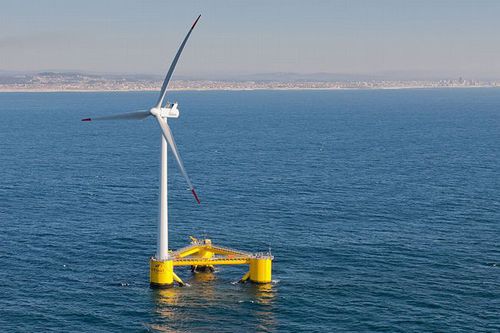August 11, 2016
Japan's New Energy Strategies: Long-Term Initiatives toward 2030 and 2050 to be Conducted by Ministries
Keywords: Climate Change Energy Policy Renewable Energy

Image by Untrakdrover Some Rights Reserved.
The Ministry of Economy, Trade and Industry (METI) and the Cabinet Office of Japan successively announced their long-term strategies in the energy field. METI has compiled measures and policies for implementing an energy mix in 2030 with a focus on energy conservation and expansion of renewable energy. The Cabinet Office will also promote research and development of innovative energy-related technologies, which is expected to drastically cut greenhouse gases by 2050. Below, we share a report on an initiative taken by the nation to promote self-sufficient energy supply utilizing solar light and hydrogen. This article is a summary of the report, reproduced with permission from Smart Japan. Smart Japan is an online media services provider specializing in energy conservation, storage and generation.
METI formulated the Innovative Energy Strategy, and launched it on April 18, 2016. On the 19th, the following day, the Energy and Environment Innovation Strategy (NESTI 2050), which was compiled by the Council for Science, Technology and Innovation of Cabinet Office, was submitted to the Prime Minister. It is difficult to find differences based only on the names of each strategy, but the former covers a wide range of energy policies toward 2030, and the latter focuses on innovative energy-related technologies targeting the year 2050.
METI's Innovative Energy Strategy consists of five key tactics. The first two points are the thorough implementation of energy conservation and the maximum introduction of renewable energy. In addition, the ministry aims to build a new energy system that doesn't depend on electric power companies, to create a new market utilizing IoT (Internet of Things) and hydrogen, and to realize the Fukushima New Energy Community Initiative, a scheme predicting trends in future societies.
The most notable point are the measures in four fields for creating a new market: 1) drastic conversion of energy conservation policies; 2) expansion of low-carbon power sources, including renewable energy; 3) implementation of negawatt exchanges using IoT; and 4) promotion of supply chain establishment to realize a hydrogen-based society. Each field is scheduled to start consolidating new rules and systems by the end of 2016.
The aim of METI's Innovative Energy Strategy is to achieve a reduction target for greenhouse gases for 2030. To attain this goal, an energy mix set out to lower the ratio of thermal power generation is necessary. As for nuclear power generation, which holds a 20-22% ratio in the energy mix, there are no plans given in the strategy. Nuclear power may be regarded as an existing technology and not an innovative one, but this fact also indicates METI's delicate position in the strategy.
Innovative Storage Cells and Future Solar Power Generation
On the other hand, the Cabinet Office emphasizes technology innovation with its NESTI 2050 strategy. This strategy deals with integration technologies for energy systems utilizing artificial intelligence (AI) and IoT, three core technologies composing the energy system, and innovative technologies covering seven fields. By having each technology combined, the Cabinet Office aims to materialize "Society 5.0" by 2050, the world's most-advanced intelligent society.
The innovative technologies in seven fields include cutting edge storage batteries that would extend electric vehicle's cruising range to over 700 kilometers, technologies for generation, storage and utilization of non-CO2 emitting hydrogen, and photovoltaic power generation systems with double the efficiency as currently available systems.
In 2013, the Cabinet Office formulated the Innovation Plan for Environmental Energy Technology as a precursor to its Energy and Environment Innovation Strategy, along with the roadmap comprising total of 37 elements relating to energy technologies. The roadmap stipulates general goal for 2050 concerning from high efficiency coal power generation to earth monitoring and climate change forecast.
Similarly, there will be another roadmap to be developed and implemented for innovative technologies subject to the Energy and Environment Innovation Strategy whose aim is to reduce present GHG emission by half by 2050. In December 2015, in COP21 held in Paris, participating countries had reached agreement to keep global warming under two degrees Celsius.
In order to achieve this goal by 2050, we need to reduce GHG by more than 30 billion tons of CO2 equivalent. Of this, up to more than 10 billion tons is expected to be reduced by the world, by utilizing the innovative technologies in the strategy. While there remain a number of issues to be addressed before reaching the goal, Japan has a good chance to take the lead in energy-related innovative technologies.
Source: Smart Japan (in Japanese)
Related JFS Articles
- MOE Forecasts 33% Renewables by 2030, Nuclear Plants Not Prerequisite for Energy Mix
- The Challenges Facing Full-Scale Renewable Energy Development and Expectations of Electricity System Reform (Part 1)
- The Challenges Facing Full-Scale Renewable Energy Development and Expectations of Electricity System Reform (Part 2)
Related
"JFS Newsletter"
- Shaping Japan's Energy toward 2050 Participating in the Round Table for Studying Energy Situations
- Implementation of the Paris Climate Agreement: A Report on Japan's Round Table for Studying Energy Situations
- Renewable Energy Hopes and Hurdles Amid Full Liberalization of Japan's Electricity Market
- Shimokawa Town, Hokkaido: Establishing an Energy-Sustainable Small Town Management Model with Local Forest Resources (Part 2)
- Shimokawa Town, Hokkaido: Establishing an Energy-Sustainable Small Town Management Model with Local Forest Resources (Part 1)


